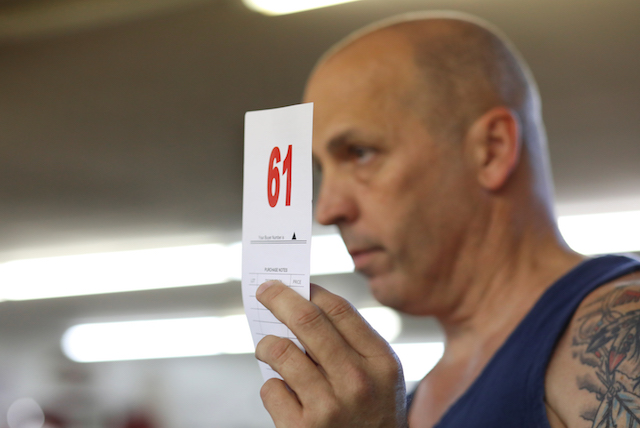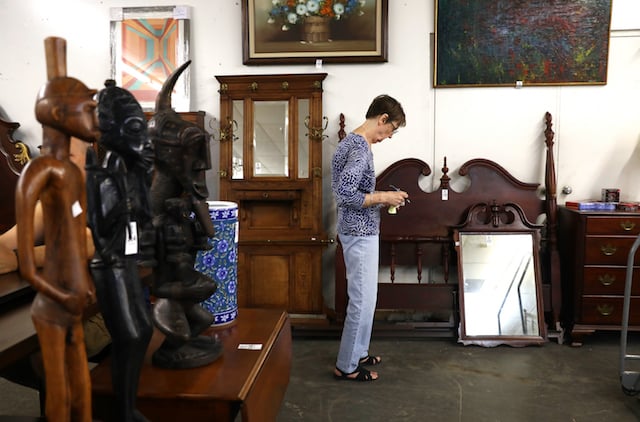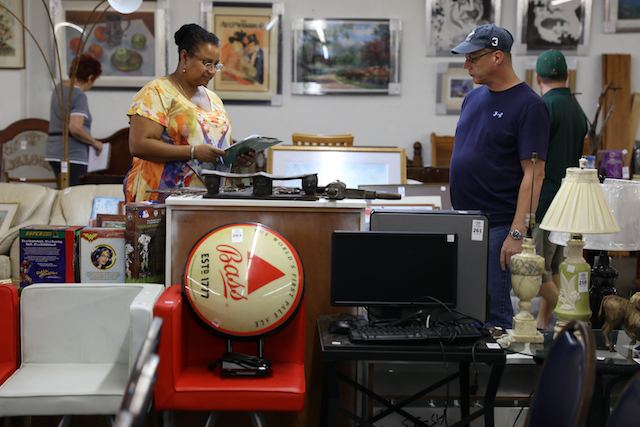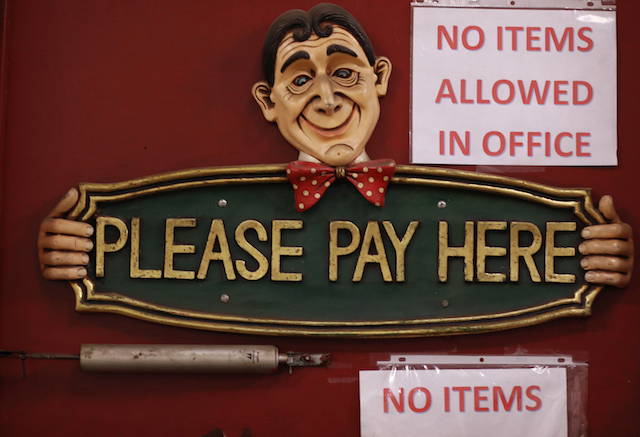Going to an Auction? 10 Tips to Help You Bid Like a Pro and Save Money

On an old card table, two ostrich eggs perch on stands. A Beatles lunchbox — Sgt. Pepper’s Lonely Hearts Club Band — waits. An old spiral spinning top sits at rest.
Soon all these items will have their moment on the auction block.
That’s because it’s the first Saturday of October, which means Bay Area Auction Services is hosting its monthly estate furnishings sale, featuring antiques, art, collectables, coins, home furnishings, jewelry, tools, patio gear — anything you might find in your home.
Really, it’s a giant, highly-interactive garage sale where you can save tons of money and pick up some real gems — the perfect Penny Hoarder weekend activity.
Greg Farner is co-owner and auctioneer at Bay Area Auction Services — one of the largest in the southeast.

He can attest that people flock to auctions for a good deal. Even he takes advantage of them, occasionally toting home artwork, furniture or a car.
Farner stocks his auction hall with items guaranteed to sell. “Oh, it will all sell,” Farner says confidently before the auction begins, as I glance at the cheetah-print couches.
If something doesn’t initially receive a bid, Farner will break out various strategies.
He might combine items — two couches for the price of one. Or he might break up lots, meaning if a “lot” includes a set of paintings, he’ll begin selling them one by one.
If worse comes to worst, he’ll announce “first for a dollar,” which means the first bidder to raise their number gets the item for a dollar.
When I ask Farner about examples of great deals he’s seen, he nods to a stack of mattresses in the back. He got them from the neighboring furniture store — all still wrapped in plastic. Originally priced at $1,000-$2,000, he predicts these will go for $200-$300.
10 Tips to Surviving Your First Auction

Between the auctioneer’s “bippity, boppity, bow-wow, bow-wow” talk and the quick flash of bidders’ numbers, auctions might be a little overwhelming for the first timers.
To ease you into the process and the glory of auctions, I spoke with Farner and veteran auction-goers to compile some tips.
These tips will help get you started, but “after you do it a couple of times, you’ll feel like a pro,” Farner assures me.
Once you know what you’re doing, you can come out with awesome deals.
1. Preview the goods.

Auction houses offer previews, which allow you to mill about and look at the items up for bid. Perhaps you were eyeing a dining room set. Check out the condition, the color, whatever you need to before bidding on it.
Bay Area Auction hosts a preview the Friday before each auction, and it also opens its doors early on Saturday. When I arrive an hour and a half early, people are already there, scoping out the territory.
If you can’t get out beforehand? Some auctions have online previews.
2. Do your research.

Something catch your eye at the preview? Start doing some research.
“People know what the price should be based on their retail experience, and so they should know what their limit should be,” Farner says.
Angie Hammons is attending the auction with her husband and her mother, Sally Burnette. Both are avid auction fans; Burnette even used to work at Bay Area Auction.
I ask for their best insider tips, and Hammons emphasizes the importance of research.
“Check out what you could buy it for for new so you know what you’re not willing to go over,” she explains.
Her husband chimes in: “I saw chrome garbage cans that sold for $40 a piece. Then I was in Target the other day and see the same thing for $29.99.”
3. Grab a catalog.

At Bay Area Auction, each item or lot has a sticker with the lot number scratched on it.
Farner hands me a catalog, which he grabbed from the sign-in desk. It outlines, in a classic typewriter font, the lot number, quantity (number of items in the lot) and a description.
“22, 4 VINTAGE BASEBALL CARD HBC”
“112A, 2 HITCHCOCK PLANT STAND 2 X THE MONEY”
“423, 1 BLUE PATIO ARMCHAIRS/FOOTSTOOL & END TABLES”
HBC, by the way, means “high bidder’s choice.” This means you’re promising to pay $25 for each item in the lot, for example.
And “2x the money” indicates the lot goes together, so the auctioneer likely won’t break it up to sell individually.
This catalog will be your bible. Here, highlight items you’re interested in and take any important research notes — see more below.
4. Set a cap.

Whatever you do, do not get carried away.
I’m going to make a bold statement here and compare a day at an auction similar to a day at a casino — you have to know when to stop.
Hammons says the price can rack up faster than you think.
“It can go back and forth and, before you know it, you wanted to pay $40 for something, and you wind up paying $75 for it,” she says.
That’s the beauty of research. You’ll know realistically what the item should sell for. By writing down a cap in your catalog, you’ll hold yourself accountable in the heat of the moment.
5. Know the premium.

At Bay Area Auction, you get what you pay for, but there’s a 10% premium. He even reminds bidders about the premium in the midst of the auction.
Always keep this — as well as taxes — in mind because it can add up quickly, Hammons says.
When Burnette worked at the auction house, she often saw panic in customers’ eyes when it was time to fork over money. “By time the people get up there to check out, they’re having buyer’s remorse,” she says.
6. Time it right.

If you don’t have a full day to conquer an auction, time it out.
You’ll get the hang of this as you attend more auctions, but if you know an item you want is lot No. 444, you don’t need to arrive right at the beginning. Wait it out and come in, say, 30 minutes before it’s up on the block.
7. Bring boxes or bags.

No one actually told me this. I suppose it’s one that’s so obvious it’s not worth mentioning. However, I wouldn’t have had a clue.
Bring cardboard boxes or bags to tote home your goods. If you’re planning to bid on various trinkets, this will be helpful.
If you have your eye on a bigger item, remember that you have to remove it from the auction, so have appropriate transportation lined up. Farner gives customers that day as well as the next to pick up items — or makes himself available by appointment.
It’s easier, though, if you take your exciting new purchase home that day.
8. Pay attention.

In the middle of the bidding, I get distracted by the people whispering — probably strategizing — around me.
But no matter the distraction, you must pay attention. You don’t want to miss the item you’ve been waiting for — nor do you want to overbid.
I can tell you it takes extreme concentration to follow what the auctioneer is saying in that boopity-bop foreign language.
9. Get a read on your fellow bidders.

Burnette says bidding can become a bit of a psychological game.
“If somebody keeps raising their number, know that person is determined to have that item, regardless,” she says.
Basically, you’re running up the item’s price. Or you’re running up the risk of getting stuck with it — at an extreme price tag.
Getting a good read on your fellow bidders might not happen immediately, but, with time and experience, you should be able to catch on.
10. Know when to walk away.

Just like my gambling analogy, you need to know when to walk away. That’s why you do your research, set your cap and gauge other bidders.
If you don’t get that cheetah-print sofa, it’s not doomsday. There are plenty of other auctions — and even online sites — where you can find those precious items.
How To Get In On The Auction Action

I ask Farner how people can get in on their local auctions. He mentions AuctionZip.com. It’s a nifty tool that allows you to type in your zip code to find every auction in your area in calendar format — plus online auctions.
And that’s another thing: Bay Area Auction offers internet bidding — for a 5% premium — so if you can’t get to the auction that day, you can place a bid online without leaving your couch.
Your Turn: Have you ever been to an auction?
Carson Kohler (@CarsonKohler) is a junior writer at The Penny Hoarder. After recently completing graduate school, she focuses on saving money — and surviving the move back in with her parents.


















